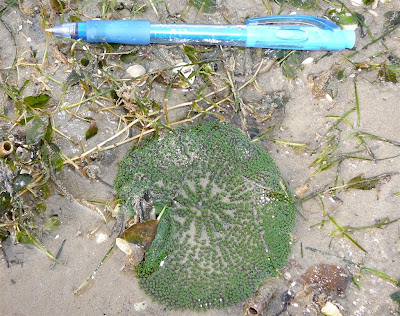
All seems ok and fine at first, but soon I found out that there are some litter along the sandbar shores. I didn't think too much at first and proceeded straight to the extreme north myself while Yikang helped me to take photos from the observation tower to monitor sandbar and cover changes over long periods of time.

This extreme part is remote and it was my first time going there. It looks ugly with the fence to deter illegal immigrants from swimming across from Johor. It is a narrow stretch of beach that goes on and on. Without the liberty of time, I had to start work.

There are many large oyster and shells around this part of the shore. Is this one being pried open for harvesting?
My first job is to actually take GPS readings along the edge of the sandbar so that I can get an outline of the current sandbar position.

While walking south from the extreme north part, I was pleasantly surprised to see many many of these tiny Stichodactyla tapetum, Stichodactyla haddoni and the Swimming anemones (Family Boloceroididae). The north part used to be almost completely barren of anemones.
A really good sign of recovery!

Walking a bit more south, I ignored most of the cyanobacteria patch as they are really too common. But this particular patch looks more interesting. Something struck my eye.

What are these pink and yellow things spreaded out in large numbers?
These bunches of pink and yellow stuff that looks like a carnation are actually eggs of a muricid snail! Why does the cyanobacteria favour these snails?

The echinoderms are making a good come-back to CJ including this sea cucumber.

And these baby sandfish sea cucumber too! Can't forget the sight of the mass death where many of these adult ones were found dead in huge numbers. Welcome back.

Along the apparently-lifeless sandbar, some markings were found.

Found a huge family of brittlestars burrowed into the sand! First time saw this. Hopefully, soon followed will be the common seastars.

Not only for brittlestars and sea cucumbers, we also found many sandstars that are very small. These babies are really cute and I hope they will grow up and live well in Chek Jawa.

These Halophila beccarii seagrasses can now be found near to the boardwalk instead of the extreme north end, and it is suggested that the fresher waters caused it.

What I couldn't stand is the enormous amount of litter found on the shores. We at first thought it might be drifted from elsewhere like Johor.

What confirms us the source of litter is this bowl of instant noodles with the remains noodles and soup in it! How can such a thing be from elsewhere? The content inside is still intact.
It must most probably be from the boardwalk, since it has been recently opened.
If it's true, what a shame.

After the terrible incident of stepping on a sharp object the other time, one has to be extremely careful because there are planks with rusty nails pointing upwards. Watch where you walk!

The busy day ended with a shot of the rear beacon which I have never took effort to notice it.
2 comments:
wah~~~
next time you head down to CJ, can let me know? hope u dun mind me tagging along!!
sure Juanhui. It'll be nice if you can come along.
Post a Comment